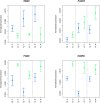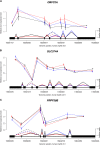Sex-specific and lineage-specific alternative splicing in primates
- PMID: 20009012
- PMCID: PMC2813474
- DOI: 10.1101/gr.099226.109
Sex-specific and lineage-specific alternative splicing in primates
Abstract
Comparative studies of gene regulation suggest an important role for natural selection in shaping gene expression patterns within and between species. Most of these studies, however, estimated gene expression levels using microarray probes designed to hybridize to only a small proportion of each gene. Here, we used recently developed RNA sequencing protocols, which sidestep this limitation, to assess intra- and interspecies variation in gene regulatory processes in considerably more detail than was previously possible. Specifically, we used RNA-seq to study transcript levels in humans, chimpanzees, and rhesus macaques, using liver RNA samples from three males and three females from each species. Our approach allowed us to identify a large number of genes whose expression levels likely evolve under natural selection in primates. These include a subset of genes with conserved sexually dimorphic expression patterns across the three species, which we found to be enriched for genes involved in lipid metabolism. Our data also suggest that while alternative splicing is tightly regulated within and between species, sex-specific and lineage-specific changes in the expression of different splice forms are also frequent. Intriguingly, among genes in which a change in exon usage occurred exclusively in the human lineage, we found an enrichment of genes involved in anatomical structure and morphogenesis, raising the possibility that differences in the regulation of alternative splicing have been an important force in human evolution.
Figures




Similar articles
-
Conservation, evolution, and regulation of splicing during prefrontal cortex development in humans, chimpanzees, and macaques.RNA. 2018 Apr;24(4):585-596. doi: 10.1261/rna.064931.117. Epub 2018 Jan 23. RNA. 2018. PMID: 29363555 Free PMC article.
-
Global analysis of alternative splicing differences between humans and chimpanzees.Genes Dev. 2007 Nov 15;21(22):2963-75. doi: 10.1101/gad.1606907. Epub 2007 Oct 31. Genes Dev. 2007. PMID: 17978102 Free PMC article.
-
Evolution of alternative splicing in primate brain transcriptomes.Hum Mol Genet. 2010 Aug 1;19(15):2958-73. doi: 10.1093/hmg/ddq201. Epub 2010 May 11. Hum Mol Genet. 2010. PMID: 20460271 Free PMC article.
-
Tissue specific glucocorticoid receptor expression, a role for alternative first exon usage?Biochem Pharmacol. 2006 Nov 30;72(11):1529-37. doi: 10.1016/j.bcp.2006.07.005. Epub 2006 Aug 22. Biochem Pharmacol. 2006. PMID: 16930562 Review.
-
The 3D-Evo Space: Evolution of Gene Expression and Alternative Splicing Regulation.Annu Rev Genet. 2022 Nov 30;56:315-337. doi: 10.1146/annurev-genet-071719-020653. Epub 2022 Sep 2. Annu Rev Genet. 2022. PMID: 36055647 Review.
Cited by
-
Transcriptome analysis reveals strain-specific and conserved stemness genes in Schmidtea mediterranea.PLoS One. 2012;7(4):e34447. doi: 10.1371/journal.pone.0034447. Epub 2012 Apr 4. PLoS One. 2012. PMID: 22496805 Free PMC article.
-
A comparison of methods for differential expression analysis of RNA-seq data.BMC Bioinformatics. 2013 Mar 9;14:91. doi: 10.1186/1471-2105-14-91. BMC Bioinformatics. 2013. PMID: 23497356 Free PMC article.
-
Identification of differences in human and great ape phytanic acid metabolism that could influence gene expression profiles and physiological functions.BMC Physiol. 2010 Oct 8;10:19. doi: 10.1186/1472-6793-10-19. BMC Physiol. 2010. PMID: 20932325 Free PMC article.
-
Evolutionary genetics in wild primates: combining genetic approaches with field studies of natural populations.Trends Genet. 2010 Aug;26(8):353-62. doi: 10.1016/j.tig.2010.05.005. Epub 2010 Jun 25. Trends Genet. 2010. PMID: 20580115 Free PMC article. Review.
-
Sex differences in the intergenerational inheritance of metabolic traits.Nat Metab. 2022 May;4(5):507-523. doi: 10.1038/s42255-022-00570-4. Epub 2022 May 30. Nat Metab. 2022. PMID: 35637347 Review.
References
-
- Abzhanov A, Protas M, Grant BR, Grant PR, Tabin CJ. Bmp4 and morphological variation of beaks in Darwin's finches. Science. 2004;305:1462–1465. - PubMed
-
- Balashova VA, Abdulkadyrov KM. Cellular composition of hemopoietic tissue of the liver and spleen in the human fetus. Arkh Anat Gistol Embriol. 1984;86:80–83. - PubMed
-
- Britten RJ, Davidson EH. Repetitive and non-repetitive DNA sequences and a speculation on the origins of evolutionary novelty. Q Rev Biol. 1971;46:111–138. - PubMed
Publication types
MeSH terms
Substances
Grants and funding
LinkOut - more resources
Full Text Sources
Other Literature Sources
Molecular Biology Databases
